YAMAHA GRIZZLY 700 2020 Owners Manual
Manufacturer: YAMAHA, Model Year: 2020, Model line: GRIZZLY 700, Model: YAMAHA GRIZZLY 700 2020Pages: 182, PDF Size: 7.18 MB
Page 151 of 182
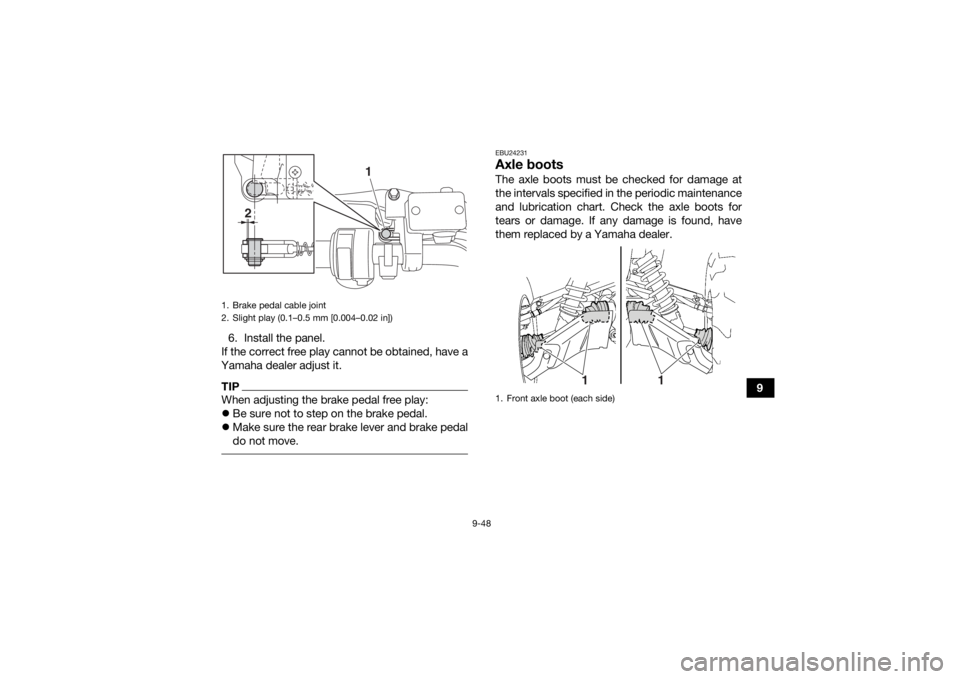
9-48
9
6. Install the panel.
If the correct free play cannot be obtained, have a
Yamaha dealer adjust it.
TIPWhen adjusting the brake pedal free play:
Be sure not to step on the brake pedal.
Make sure the rear brake lever and brake pedal
do not move.
EBU24231Axle bootsThe axle boots must be checked for damage at
the intervals specified in the periodic maintenance
and lubrication chart. Check the axle boots for
tears or damage. If any damage is found, have
them replaced by a Yamaha dealer.
1. Brake pedal cable joint
2. Slight play (0.1–0.5 mm [0.004–0.02 in])
1
2
1. Front axle boot (each side)
1
1
UBDE60E0.book Page 48 Monday, April 22, 2019 4:12 PM
Page 152 of 182
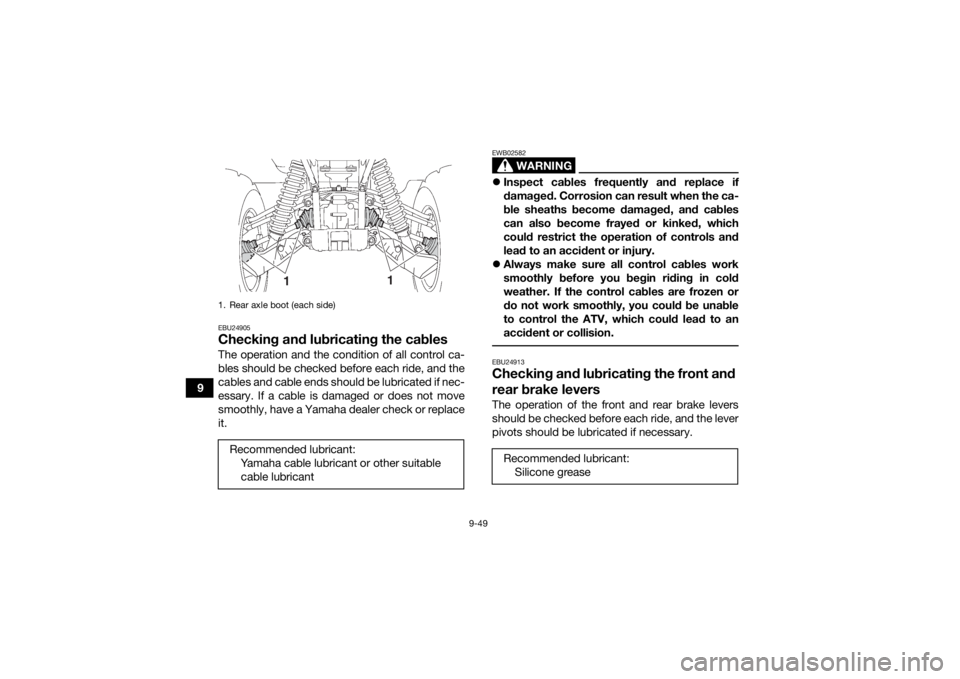
9-49
9
EBU24905Checking and lubricating the cablesThe operation and the condition of all control ca-
bles should be checked before each ride, and the
cables and cable ends should be lubricated if nec-
essary. If a cable is damaged or does not move
smoothly, have a Yamaha dealer check or replace
it.
WARNING
EWB02582Inspect cables frequently and replace if
damaged. Corrosion can result when the ca-
ble sheaths become damaged, and cables
can also become frayed or kinked, which
could restrict the operation of controls and
lead to an accident or injury.
Always make sure all control cables work
smoothly before you begin riding in cold
weather. If the control cables are frozen or
do not work smoothly, you could be unable
to control the ATV, which could lead to an
accident or collision. EBU24913Checking and lubricating the front and
rear brake leversThe operation of the front and rear brake levers
should be checked before each ride, and the lever
pivots should be lubricated if necessary.
1. Rear axle boot (each side)Recommended lubricant:
Yamaha cable lubricant or other suitable cable lubricant
1
1
Recommended lubricant:
Silicone grease
UBDE60E0.book Page 49 Monday, April 22, 2019 4:12 PM
Page 153 of 182
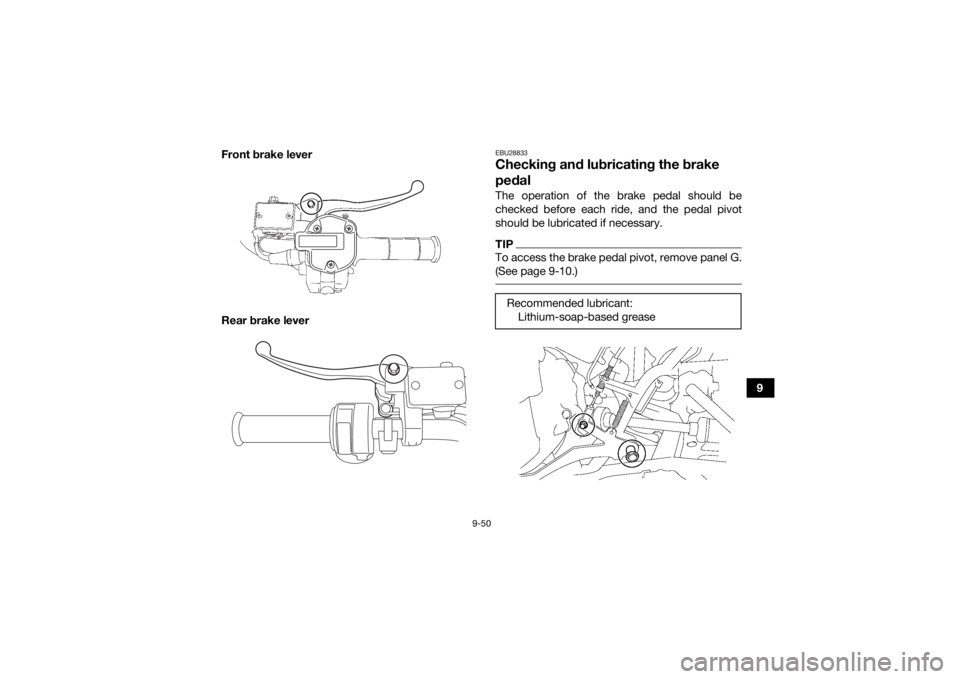
9-50
9
Front brake lever
Rear brake lever
EBU28833Checking and lubricating the brake
pedalThe operation of the brake pedal should be
checked before each ride, and the pedal pivot
should be lubricated if necessary.TIPTo access the brake pedal pivot, remove panel G.
(See page 9-10.) Recommended lubricant:
Lithium-soap-based grease
UBDE60E0.book Page 50 Monday, April 22, 2019 4:12 PM
Page 154 of 182
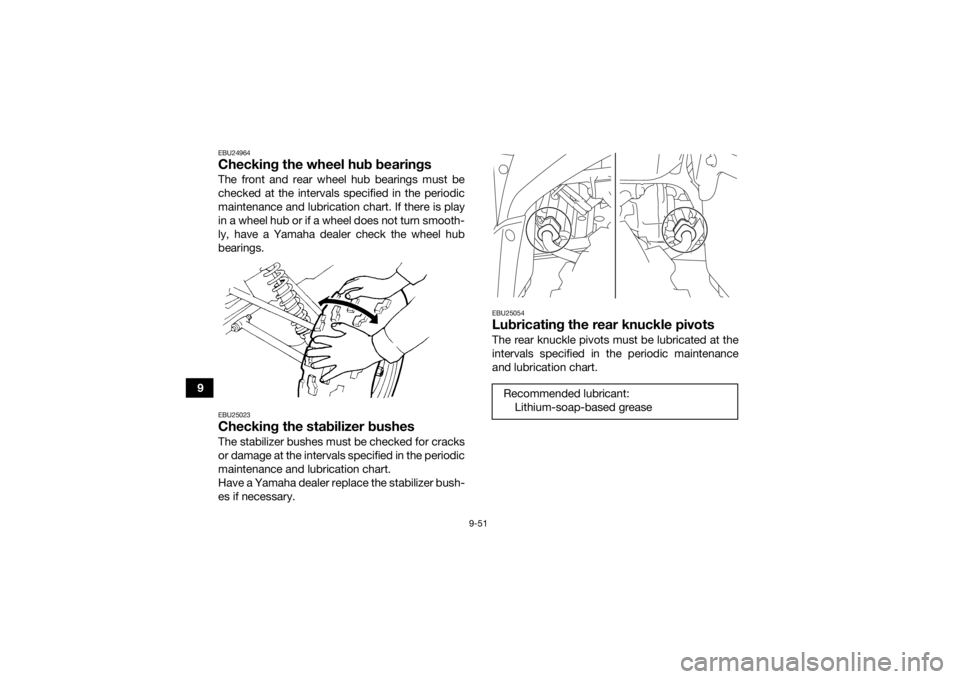
9-51
9
EBU24964Checking the wheel hub bearingsThe front and rear wheel hub bearings must be
checked at the intervals specified in the periodic
maintenance and lubrication chart. If there is play
in a wheel hub or if a wheel does not turn smooth-
ly, have a Yamaha dealer check the wheel hub
bearings.EBU25023Checking the stabilizer bushesThe stabilizer bushes must be checked for cracks
or damage at the intervals specified in the periodic
maintenance and lubrication chart.
Have a Yamaha dealer replace the stabilizer bush-
es if necessary.
EBU25054Lubricating the rear knuckle pivotsThe rear knuckle pivots must be lubricated at the
intervals specified in the periodic maintenance
and lubrication chart.Recommended lubricant:Lithium-soap-based grease
UBDE60E0.book Page 51 Monday, April 22, 2019 4:12 PM
Page 155 of 182
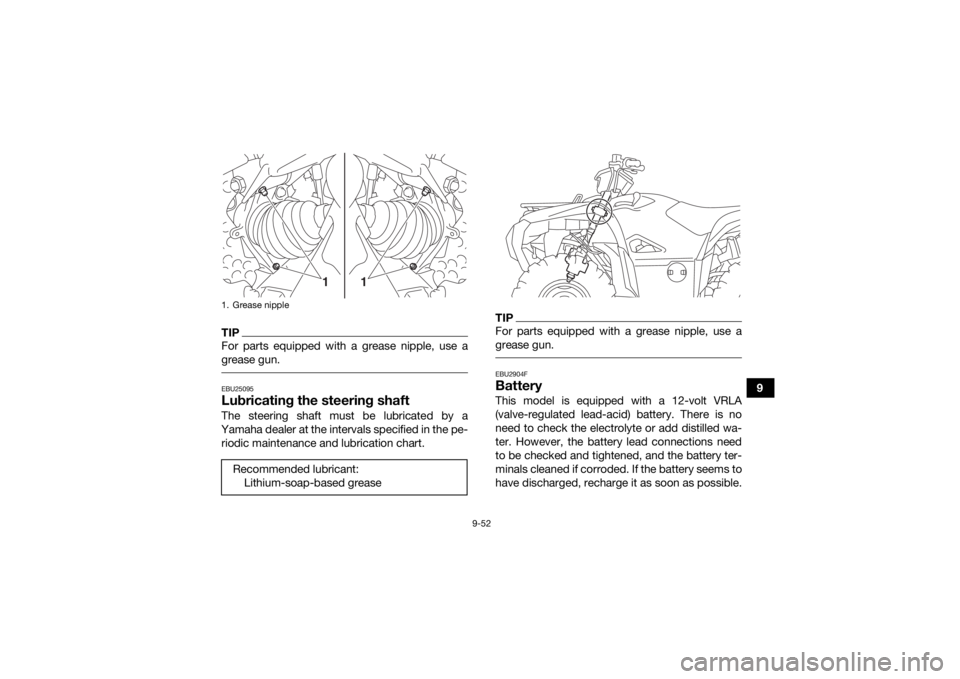
9-52
9
TIPFor parts equipped with a grease nipple, use a
grease gun. EBU25095Lubricating the steering shaftThe steering shaft must be lubricated by a
Yamaha dealer at the intervals specified in the pe- riodic maintenance and lubrication chart.
TIPFor parts equipped with a grease nipple, use a
grease gun. EBU2904FBatteryThis model is equipped with a 12-volt VRLA
(valve-regulated lead-acid) battery. There is no
need to check the electrolyte or add distilled wa-
ter. However, the battery lead connections need
to be checked and tightened, and the battery ter-
minals cleaned if corroded. If the battery seems to
have discharged, recharge it as soon as possible.
1. Grease nippleRecommended lubricant: Lithium-soap-based grease
1
1
UBDE60E0.book Page 52 Monday, April 22, 2019 4:12 PM
Page 156 of 182
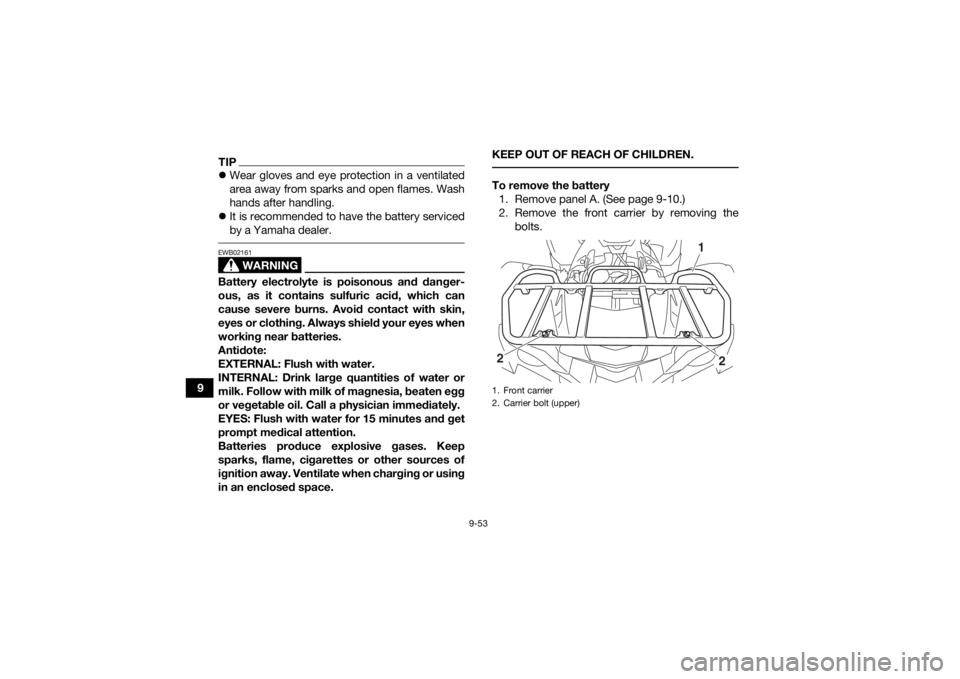
9-53
9
TIPWear gloves and eye protection in a ventilated
area away from sparks and open flames. Wash
hands after handling.
It is recommended to have the battery serviced
by a Yamaha dealer.
WARNING
EWB02161Battery electrolyte is poisonous and danger-
ous, as it contains sulfuric acid, which can
cause severe burns. Avoid contact with skin,
eyes or clothing. Always shield your eyes when
working near batteries.
Antidote:
EXTERNAL: Flush with water.
INTERNAL: Drink large quantities of water or
milk. Follow with milk of magnesia, beaten egg
or vegetable oil. Call a physician immediately.
EYES: Flush with water for 15 minutes and get
prompt medical attention.
Batteries produce explosive gases. Keep
sparks, flame, cigarettes or other sources of
ignition away. Ventilate when charging or using
in an enclosed space. KEEP OUT OF REACH OF CHILDREN.
To remove the battery
1. Remove panel A. (See page 9-10.)
2. Remove the front carrier by removing the bolts.1. Front carrier
2. Carrier bolt (upper)
1
2
2
UBDE60E0.book Page 53 Monday, April 22, 2019 4:12 PM
Page 157 of 182
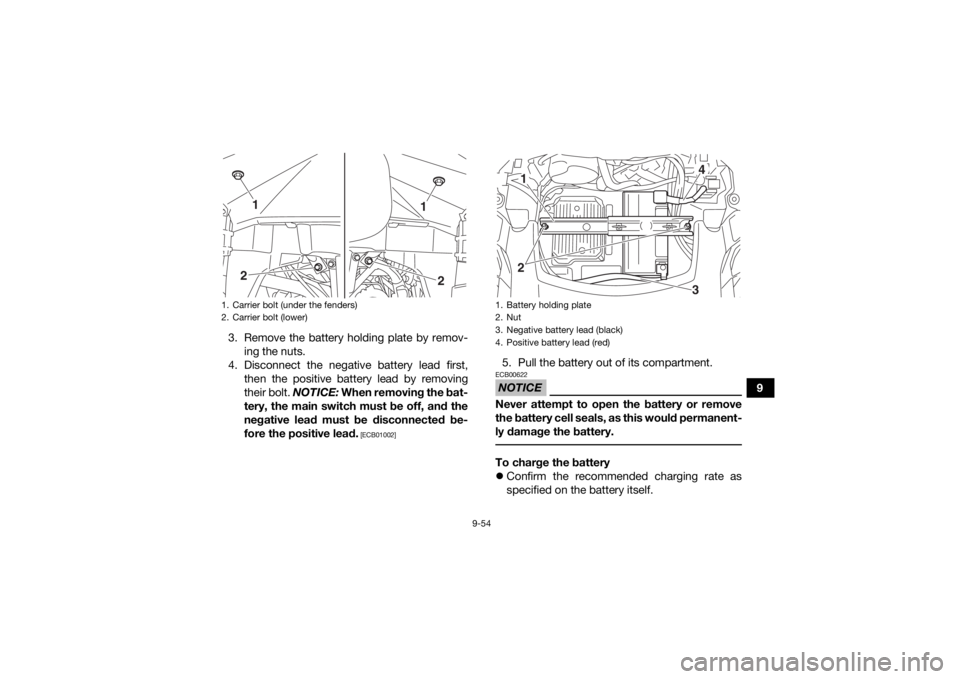
9-54
9
3. Remove the battery holding plate by remov-
ing the nuts.
4. Disconnect the negative battery lead first, then the positive battery lead by removing
their bolt. NOTICE: When removing the bat-
tery, the main switch must be off, and the
negative lead must be disconnected be-
fore the positive lead.
[ECB01002]
5. Pull the battery out of its compartment.NOTICEECB00622Never attempt to open the battery or remove
the battery cell seals, as this would permanent-
ly damage the battery. To charge the battery
Confirm the recommended charging rate as
specified on the battery itself.
1. Carrier bolt (under the fenders)
2. Carrier bolt (lower)
1
2
2
1
1. Battery holding plate
2. Nut
3. Negative battery lead (black)
4. Positive battery lead (red)
12
43
UBDE60E0.book Page 54 Monday, April 22, 2019 4:12 PM
Page 158 of 182
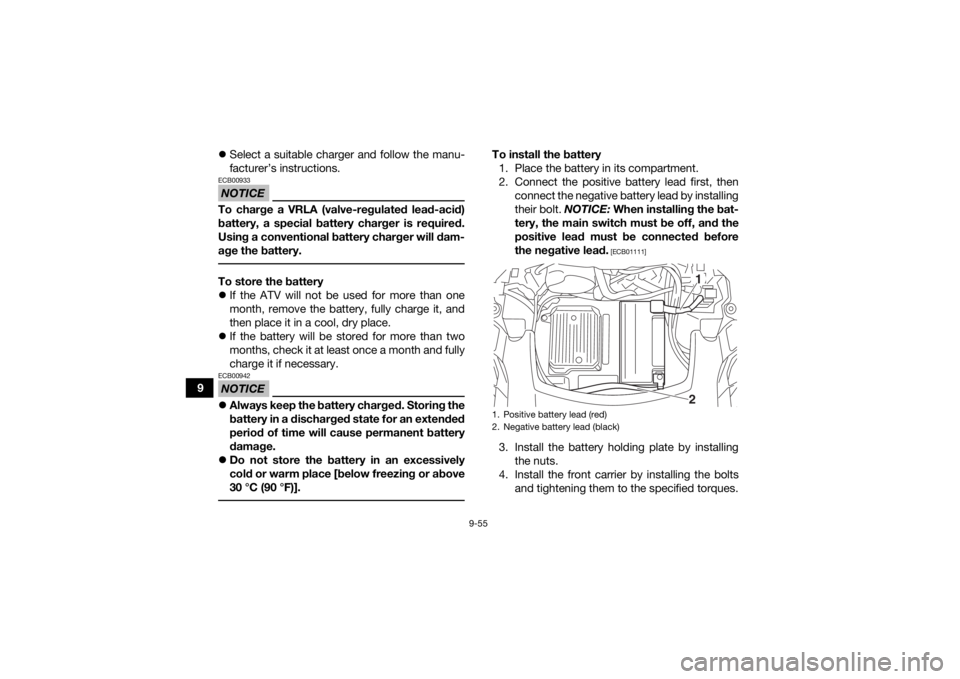
9-55
9
Select a suitable charger and follow the manu-
facturer’s instructions.
NOTICEECB00933To charge a VRLA (valve-regulated lead-acid)
battery, a special battery charger is required.
Using a conventional battery charger will dam-
age the battery. To store the battery
If the ATV will not be used for more than one
month, remove the battery, fully charge it, and
then place it in a cool, dry place.
If the battery will be stored for more than two
months, check it at least once a month and fully
charge it if necessary.NOTICEECB00942Always keep the battery charged. Storing the
battery in a discharged state for an extended
period of time will cause permanent battery
damage.
Do not store the battery in an excessively
cold or warm place [below freezing or above
30 °C (90 °F)].
To install the battery
1. Place the battery in its compartment.
2. Connect the positive battery lead first, then connect the negative battery lead by installing
their bolt. NOTICE: When installing the bat-
tery, the main switch must be off, and the
positive lead must be connected before
the negative lead.
[ECB01111]
3. Install the battery holding plate by installing the nuts.
4. Install the front carrier by installing the bolts and tightening them to the specified torques.1. Positive battery lead (red)
2. Negative battery lead (black)
12
UBDE60E0.book Page 55 Monday, April 22, 2019 4:12 PM
Page 159 of 182

9-56
9
5. Install the panel.
TIP
Make sure the positive and negative battery
leads are installed as shown.
Fully charge the battery before installing it.
EBU30525Replacing a fuse
Tightening torques:
Carrier bolt (upper):34 N·m (3.4 kgf·m, 25 lb·ft)
Carrier bolt (lower): 34 N·m (3.4 kgf·m, 25 lb·ft)
Carrier bolt (under the fenders): 7 N·m (0.7 kgf·m, 5.2 lb·ft)
1. Fuse box
2. Main fuse
3. EPS fuse
4. Fuel injection system spare fuse
5. Fuel injection system fuse
2345
1
UBDE60E0.book Page 56 Monday, April 22, 2019 4:12 PM
Page 160 of 182
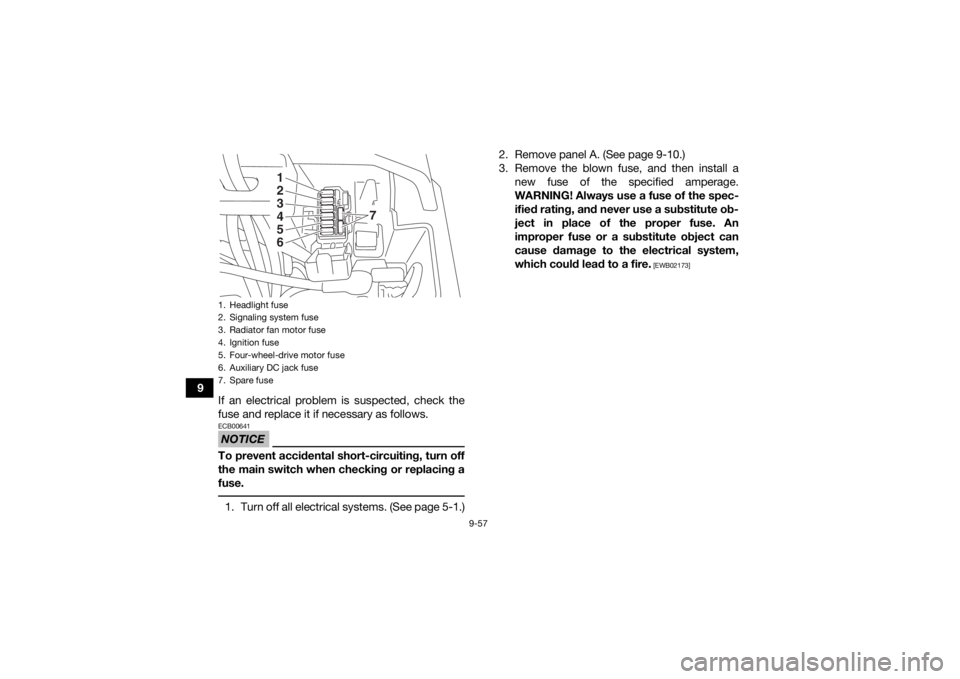
9-57
9If an electrical problem is suspected, check the
fuse and replace it if necessary as follows.
NOTICEECB00641To prevent accidental short-circuiting, turn off
the main switch when checking or replacing a
fuse. 1. Turn off all electrical systems. (See page 5-1.) 2. Remove panel A. (See page 9-10.)
3. Remove the blown fuse, and then install a
new fuse of the specified amperage.
WARNING! Always use a fuse of the spec-
ified rating, and never use a substitute ob-
ject in place of the proper fuse. An
improper fuse or a substitute object can
cause damage to the electrical system,
which could lead to a fire.
[EWB02173]
1. Headlight fuse
2. Signaling system fuse
3. Radiator fan motor fuse
4. Ignition fuse
5. Four-wheel-drive motor fuse
6. Auxiliary DC jack fuse
7. Spare fuse
123456
7
UBDE60E0.book Page 57 Monday, April 22, 2019 4:12 PM